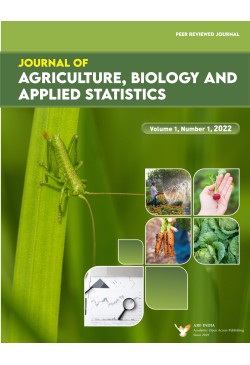
Journal of Agriculture, Biology and Applied Statistics
Frequency :Bi-Annual
ISSN :2583-4185
Peer Reviewed Journal
“Price Spread of Marketing Channels of Tomato Crops in Chitrakoot District of Uttar Pradesh”
Tomatoes are used in many dishes including soup, salad, pickles, ketchup, puree, and sauces. It doesn’t matter how much yield you get if the farmer doesn’t get paid for it! As a result, marketing plays a vital role in increasing the farmer’s yield. Profitable production requires high quality vegetables to meet market demands. An agricultural grower’s choice of vegetable depends on the market’s demand and preferences. A lack of contact with the market channel sometimes prevents vegetable growers from receiving a fair price for their hard-earned produce. Marketing cost and margin analysis benefits both the seller and the buyer. The research used both primary and secondary data sources. An agricultural survey schedule was used to interview farmers to collect data on their income, employment, and farm activities for the 2018-19 agricultural years. Each of the five blocks in Chitrakoot district has its own distinct personality and culture. Ten farmers were chosen at random from each list A sample of 40 tomato growers from the 2018-19 production year were interviewed for the study. Channel III (P-W-R-C) received the most Tomatoes, accounting for 45.5% of the total disposed. During the marketing of Tomato, the producer, wholesaler, village trader, and retailer each incurred Rs.45/- per quintal marketing cost. This worked out to Rs. 612/- per quintal in Channel II, and Rs. 403/- per quintal in Channel III and IV. It was 270/- per quintal for wholesalers and 217/- for village traders in channel III. Consumption was Rs.1142/- per quintal in Channels I, II, III, and IV. Tomato price spread in channel-I was 96.09 percent, while marketing cost was 3.94 percent. Producer and Retailer paid 9.79% of marketing costs in channel II. Consumers paid Rs. 1410/qt., with producers taking 46.81 per cent of the profit. Producer, Wholesaler, and retailer marketing costs in channel III were 10.41%. Consumers paid Rs. 1473/qt in channel-III, with producers owning 43.11 per cent of the product. Producers, Village traders, and retailers spent 10.41% on marketing in channel IV. 1643/qt, with a 39.52 percent producer share. Channel II had the highest market margin at 43.40 %. In the Chitrakoot district, channel I was found to be more profitable than channels II, III,
Keywords: Tomato, Marketing Costs, Marketing Channel
Genetic Variation for Quantitative Traits among Teak (Tectona grandis L) clones
Possibilities of Use of Double Emulsions in the Food Industry
Determinants and effect of KVK Adoption on Various Efficiency Measures of Farms in Khargone District of Madhya Pradesh
Modeling and Forecasting of Urad in India
“Costs, Returns of Sorghum in Bhind District of Madhya Pradesh”